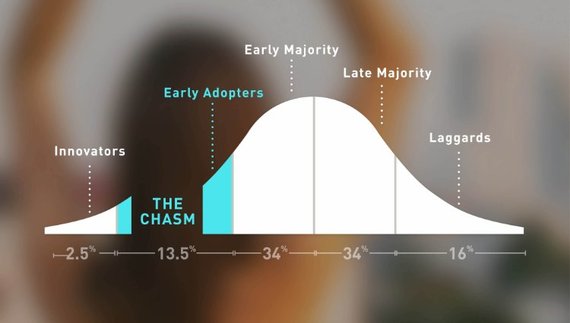This is why I got the Google Glass, and then never touched it after six hours; why I wore the Fitbit for three days, and why I flew my DJI Phantom 2 drone all but once!
Second, let us describe what tipping means, because to see mass adoption, you first have to tip! To understand tipping, we have to go back to the theory of diffusion of innovation form Everett Rogers, Geoffrey Moore's Crossing the Chasm and, Malcolm Gladwell's The Tipping Point.
I will spare you the pain of reading three books. See the image below.
What you are looking at, is the theory of diffusion of innovation, meets the chasm, meets the tipping point. You are welcome -- three books in one image.

Essentially, you need to get to 16 percent of your total addressable market (TAM) to "tip" the scales, and then eventually see mass adoption. Lets have some fun with what mass adoption looks like in various markets.
There are roughly 300 million individuals in the U.S., let us estimate half would possibly wear a smart watch and of that half, one third can afford a $400-600 smart watch. So we are looking at one sixth of the U.S. population as the TAM for the Apple Watch.
This means, in the U.S., Apple has to sell 50 million watches to claim mass adoption, and with the world's population at seven billion, and a TAM at one twelfth globally (instead of a TAM of one sixth in the U.S.) Apple would need to sell almost 600 million watches to claim "mass adoption" globally.
I am being too overzealous, lets say the tipping point is half my back of the napkin math above, and getting to mass adoption is easier than Everett Rogers estimated in the theory of diffusion of innovation, because after all, this is Apple.
So mass adoption is 25 million in the U.S., and 300 million globally.
Here are five reasons why this will not happen (any time soon).
- The ownership experience. According to TIMEX via Bloomberg, the average American male owns/wears five watches. The males in the TAM of the Apple Watch probably own on average 7.5 watches (higher disposable income). The ownership experience of a watch is one-to-many. If you are replacing my watch, you have to replace 5 to 7.5 watches. I am going to let you guys comment on how many watches the average American woman owns. This is not a simple replacement product launch, I am not swapping my Blackberry for an iPhone. I am not purchasing an iPad which is a completely new category, this is a one-to-many attempted replacement of all.
- The vanity of human kind. Watches are not completely owned for function; they are many times owned as jewelry. This means they likely serve our vanity, more than our need to tell time. The choice of a watch, is largely driven by vanity. There are currently almost 200,000 types/designs of watches for sale on Amazon.com. To get half of this number of choices for consumers, Apple would need 20 watch face designs that can go with any watch band? And 20 watch band designs that can go with any watch face? OK, I was a math minor, and this is still hurting my head. It is way more than 20 face designs and band designs!
- The iPhone. I am of the opinion that if the Apple watch can do it, the Apple iPhone can (or should) do it. No seriously. Plus, how many times I am going to upgrade my watch? Apple Watch 2.0, and 3.0, and 4.0. Nope, that is for my iPhone, not my watch. Watches stay, you fall in love with them.
- The barrier to entry. When the iPhone was introduced, the barrier to entry was high (many of those innovations are now commoditized), and the competitors were less than half a dozen. The barrier to entry for a smart watch is pretty low, Microsoft and about a dozen others a very close behind. Here is the kicker, Rolex and other luxury brands are probably even closer! The Apple watch simply does not have the runway like the iPhone had to see mass adoption.
- The smartBack. I know what you are thinking, what is a smartBack? It is my free idea to you. We need to invent a smart watch back, that I can purchase and retrofit onto my existing watches. It should have sensors, and other gizmos and I should be able to move it from watch to watch. If you make it big with this idea, be sure to pay it forward!
- I will buy one (and will probably write a review on it); I will probably only wear it six times, so watch out Apple.
See what I did there?
We need to invent a smart watch back, that I can purchase and retrofit onto my existing watches.
I write as a labor of love, in exchange I ask that you share this writing if you think others may find value.
Author's BOOK NOW AVAILABLE for purchase (Apple iBooks) or (Amazon.)



